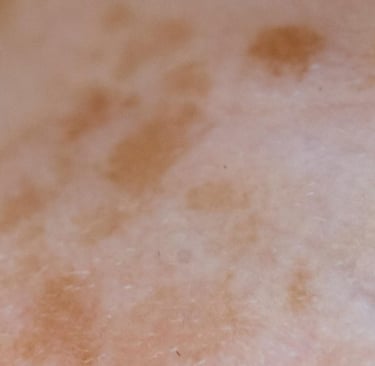NAD+ and Hyperpigmentation: A Potential Solution for Skin Health
Read about Hyperpigmentation what it is and how NAD+ can be a potential solution to solve it


Hyperpigmentation, a common skin condition characterized by darkened areas of the skin, is often caused by sun exposure, inflammation, and hormonal changes. Conditions like melasma, age spots, and post-inflammatory hyperpigmentation (PIH) can make the skin appear uneven and aged. While there are many treatments available for hyperpigmentation, emerging research suggests that NAD+ (Nicotinamide adenine dinucleotide) may offer a promising solution for enhancing skin health and potentially reducing the appearance of hyperpigmentation.
In this article, we’ll explore the relationship between NAD+ and hyperpigmentation, how it works to improve skin health, and why it may be a powerful addition to your skincare routine.
What is NAD+?
NAD+ is a coenzyme found in all living cells and plays a crucial role in various cellular processes, including energy production, DNA repair, and maintaining mitochondrial function. As we age, NAD+ levels naturally decline, which can result in a range of age-related conditions, including the acceleration of skin aging and the development of hyperpigmentation. NAD+ has been studied for its potential to improve skin health by supporting cellular regeneration, reducing oxidative stress, and promoting healthy cell turnover.
How NAD+ Can Help with Hyperpigmentation
Boosting Cellular Repair and Regeneration
NAD+ is known for its role in DNA repair and cellular regeneration. Skin cells, especially melanocytes (the cells responsible for producing melanin), are constantly exposed to environmental stressors like UV radiation, pollution, and chemicals. This damage can lead to an overproduction of melanin, causing dark spots and uneven skin tone. NAD+ supplementation may help repair the DNA damage caused by these stressors, encouraging healthier skin regeneration and reducing the appearance of dark spots over time.Reducing Inflammation
Inflammation is a key factor in the development of hyperpigmentation. Conditions like post-inflammatory hyperpigmentation (PIH) arise when skin experiences inflammation due to acne, eczema, or other irritations. NAD+ has been shown to help reduce inflammation at the cellular level, which can minimize the risk of developing PIH and promote faster healing of irritated skin. By controlling inflammation, NAD+ can help maintain a more even skin tone.Improving Skin Cell Turnover
One of the reasons hyperpigmentation persists is because of slow skin cell turnover. As we age, the regeneration of skin cells slows down, leading to the accumulation of melanin in the skin. NAD+ supports the production of sirtuins, enzymes that regulate cellular processes including aging and skin regeneration. By promoting faster skin cell turnover, NAD+ can help shed pigmented cells more efficiently, preventing the buildup of dark spots and promoting clearer, brighter skin.Enhancing the Skin's Barrier Function
NAD+ plays a crucial role in maintaining the integrity of the skin barrier. A strong skin barrier is essential for protecting the skin from external irritants, harmful UV rays, and moisture loss, all of which contribute to the development of hyperpigmentation. By supporting the skin's barrier function, NAD+ can help prevent further damage to the skin and keep it healthy and resilient.
Why NAD+ is Effective for Treating Hyperpigmentation
Unlike many topical skincare treatments, which may only target the surface layers of the skin, NAD+ works at the cellular level to address the root causes of hyperpigmentation. Its ability to repair DNA, reduce inflammation, and support cell turnover makes it a powerful tool in the fight against dark spots and uneven skin tone. Additionally, as NAD+ levels naturally decline with age, supplementing with NAD+ can help restore youthful skin vitality, reducing the signs of aging and pigmentation.
How to Incorporate NAD+ into Your Skincare Routine
NAD+ can be taken through supplements, topical treatments, or through intravenous (IV) therapy. Oral NAD+ supplements are widely available and can help increase NAD+ levels throughout the body, potentially benefiting the skin. Topical NAD+ creams and serums are also gaining popularity, as they can directly target the skin's surface while promoting deeper cellular health.
While NAD+ supplementation may offer benefits for hyperpigmentation, it's important to maintain a comprehensive skincare routine. Using sun protection daily, avoiding excessive sun exposure, and incorporating gentle exfoliants can complement the effects of NAD+ and help prevent further pigmentation.
Conclusion
NAD+ holds exciting potential as a treatment for hyperpigmentation, offering a multifaceted approach to skin health. By supporting cellular repair, reducing inflammation, promoting cell turnover, and enhancing the skin's natural barrier function, NAD+ can help reduce the appearance of dark spots and promote a more even skin tone. As research continues to explore the benefits of NAD+, it is clear that this powerful coenzyme may soon become a staple in skincare routines aimed at fighting hyperpigmentation and promoting overall skin health. If you're looking for a holistic solution to hyperpigmentation, NAD+ supplementation could be a game-changer for your skin.
